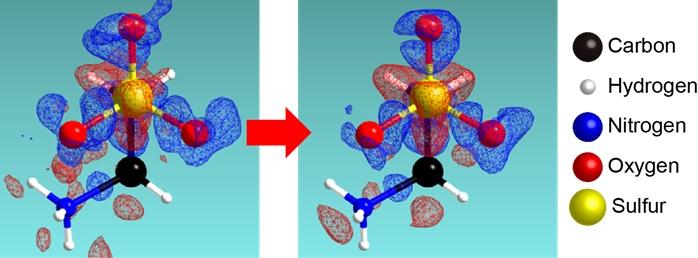Statistical inference to mimic the operating manner of highly-experienced crystallographer

Precision of crystallographic observation was improved from left to right using measurement design based on the proposed method. Differentials from actual to spherical electron densities are described by blue (positive) and red (negative) surfaces. Credit: ©Manabu Hoshino
A research team from Japan Science and Technology Agency (JST), RIKEN, and the University of Tokyo developed a novel data analysis method for prior evaluation of single crystal structure analysis.
Their proposed method is based on precise estimation of a parameter inherent in preliminary-collected small data set. They demonstrated its application to guest distinction in host-guest crystals before single crystal structure analysis and measurement design for precise crystallographic observation.
Recent development of measurement device and analysis program for single crystal structure analysis is advanced; thus, it reduces researchers' effort in crystallographic observation of molecular structure. However, researchers are sometimes trapped in “blind” measurement-analysis iterations until the result of analysis is satisfactory to their purpose.
“In almost all cases, the iterations are forced to be taken by the one of two reasons–an observed structure is imprecise or outside the scope of research purpose,” said Dr. Manabu Hoshino, a researcher at JST and RIKEN. He was dealing with this issue to improve the efficiency of single crystal structure analysis and conceived the idea for evaluating to-be-collected data and to-be-observed structure from preliminary data. This idea was implemented in statistical estimation of a parameter intrinsic to data set by Bayesian inference.
Moreover, “Highly-experienced crystallographers successfully bypass the iterations by selecting a crystal and setting experimental conditions based on careful check of preliminary-collected small data set,” said Hoshino. Further, he continued “In our method, an estimated parameter is used for mimicking professional crystallographers' crystal selection and measurement design.”
Practical utility of their proposed method was demonstrated as prior distinction of to-be-observed guest solvent molecules included in a porous host crystal. Because of the isomorphism of crystal structures comprised using a same host molecule, difference of included guest solvent molecules is usually clarified only after completing crystal structure analysis.
Hoshino and his collaborators applied their method to the preliminary small data sets collected from two host-guest crystals grown from different mixed-solvent solutions and showed that difference of the estimated parameters is usable to distinguish guest solvent molecules in these crystals.
Moreover, they utilized the estimated parameter as a means to create to-be-collected data by employing it in theoretical equations describing crystallographic data. The lowest threshold of signal-to-noise ratio to guarantee quantitatively of data was suggested from the created data. Indeed, collected data satisfying the proposed threshold enabled precise crystallographic observation for studying deformation of electron density by chemical bonding.
“Our proposed method will help researchers who have little experiences in single crystal structure analysis in the aspect of their crystal selection and measurement design,” concluded Hoshino. “I believe our method will encourage researchers to exploit developed measurement devices and analysis programs.”
Media Contact
All latest news from the category: Physics and Astronomy
This area deals with the fundamental laws and building blocks of nature and how they interact, the properties and the behavior of matter, and research into space and time and their structures.
innovations-report provides in-depth reports and articles on subjects such as astrophysics, laser technologies, nuclear, quantum, particle and solid-state physics, nanotechnologies, planetary research and findings (Mars, Venus) and developments related to the Hubble Telescope.
Newest articles

A ‘language’ for ML models to predict nanopore properties
A large number of 2D materials like graphene can have nanopores – small holes formed by missing atoms through which foreign substances can pass. The properties of these nanopores dictate many…

Clinically validated, wearable ultrasound patch
… for continuous blood pressure monitoring. A team of researchers at the University of California San Diego has developed a new and improved wearable ultrasound patch for continuous and noninvasive…

A new puzzle piece for string theory research
Dr. Ksenia Fedosova from the Cluster of Excellence Mathematics Münster, along with an international research team, has proven a conjecture in string theory that physicists had proposed regarding certain equations….



